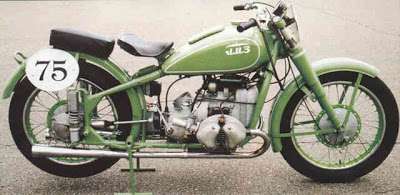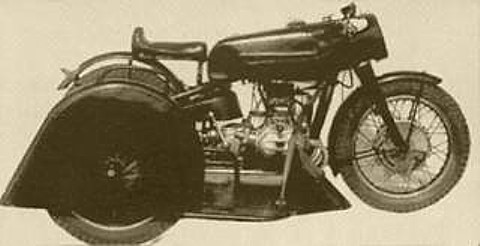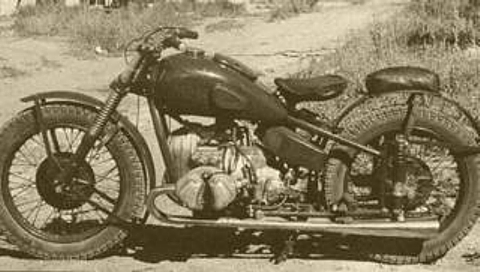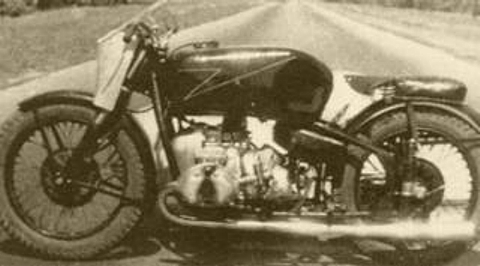
The highway-ring race was very popular in the 50’s, many outstanding racers participated in them, including Vasily Stalin, commander of the Air Force of the Moscow District . Under his leadership, one of the best racing teams was assembled, and naturally, the latest technology was delivered there. Racing motorcycles were produced in tiny lots – 20 pieces each, and the release lasted 4-5 years – each year they produced 4-5 pieces of each model.
Soviet motor-technics was in those days yesterday: after all, what came to us in the 1940s-1950s, in Europe was popular twenty years ago. Soviet racing motorcycles developed speeds of up to 100 – 120 km / h. And abroad, more powerful engines appeared before the war. That is why in the Soviet Union there was a ban on participation in racing foreign motorcycles, only those produced at our (Soviet) plants or self-made ones were allowed. But some enterprising racers took a foreign engine, altered the appearance and gave out for a makeshift machine.
It is curious that the prototype of heavy Soviet sports motorcycles was the BMW R-72 model (the army version of the civil R-71). Even in the pre-war years, the Soviet government reflected that it was better to invent models or buy licenses. After disputes and friction came to the conclusion that it is better to purchase licenses. It remained to choose a model. This was the BMW R-72 model of 1939.
In the USSR, this model, called the M-72, was launched immediately at four plants. During the war, the Moscow motor factory was evacuated to the Urals to the city of Irbit. There, on the basis of a serial motorcycle from 1944 to 1958, they created five racing models for elite road-and-ring races – M-75, M-75M, M-76, M-77, M-52S. And only one of them was miraculously preserved in the storehouses of the political museum – M-75M.
From an interview with Vladimir Konkin, the owner of the collection of Soviet racing motorcycles and the founder of the restoration workshop.
In the USSR, the history of the creation of the first sports motorcycles dates back to the early 1930s, when the first special designs appeared. In addition to individual riders, who created their own piece designs, and the factories in the pre-war period created several interesting sports motorcycles. In Taganrog it was TIZ-4, TIZ-6, TIZ-7, TIZ-51, in Leningrad C-1. In Izhevsk, several sports motorcycles were also built on the basis of IZH-7 and IZH-8. However, with the beginning of the war, these works were stopped.
From the book “The device of a motorcycle”, M; “Physical Education and Sport”, 1953:

Motorcycle C-1 A
For sporting purposes, especially in mass competitions, all models of road motorcycles are successfully used, which, after appropriate adaptation, fulfill sports standards.
The domestic motorcycle industry produces more and more models of motorcycles specifically designed for sports purposes.
In different classes after the Great Patriotic War the following models were produced:
In the class of up to 125 cm3 – M1 E; C1A; K-125C; M1 V;
up to 350 cm3 – IZH-350S; IZh-50; IZh-51; M-35;
up to 750 cm3 – M-75; M-76.
Along with sports bikes are released (in single copies) models of special racing motorcycles.
In the classroom up to 250 cm3 – GK1; C2B;
up to 350 cm3 – SCB; M-35 K; ГК1.
In 1940 in the USSR, after comparative testing of 15 different types of motorcycles of foreign brands, the BMW R-71 motorcycle was selected and recommended for serial production, which received the M-72 index in the USSR. This event can be considered one of the most significant in the history of motor industry in the USSR. In itself, the history of the production of the M-72 and its modifications has been repeatedly described, we are more interested in the M-72 as the basis for the creation of sports motorcycles. In this story there are many white spots, and, probably, we will not learn much until the end, but for now we will try to systematize the disparate facts known to us and comment on them.

Motorcycle M-75
So, on November 25, 1942, the production of M-72 motorcycles was resumed from Moscow’s motor factory, evacuated from Moscow to Irbit in November 1941, and in 1943 the IMZ designers created the M-75 engine. What the engine was, you can judge based on the “Report on the UBP and BM GBTU CA” for 1941-1945. In it, we find the following mention: “… cylinders and heads are replaced on M-72. The cylinder heads together with the valve mechanism are taken from the BMW-R-51. The volume remained 746 cc, capacity from 22 hp increased to 28 hp The M-75 has better dynamics and economy, satisfactory litre capacity, but due to a number of design flaws, it was not accepted for mass production. ” The report says exactly this: BMW-R-51. Most likely, this is an ordinary typo. R-51 had a working volume of 500 cubic cm, and the M-72 746 cc, the mounting and dimensions of the cylinders did not allow them to be installed on the M-72 without serious modifications, so we would venture to assume that several modified cylinders and heads were not installed on the first M-75 engines and the heads were not from the BMW R-51 , but from BMW R-75.
Today it is difficult to say what actually motivated the IMZ designers in 1943, apparently during the war years, the need to create a more powerful machine for the army came to the fore, and they were thinking about its sporting use in the second turn. In addition to the army’s designation, the M-75, according to the design of the designers, could become a good civil motorcycle. Upper-valve engine (overhead-valve) greatly expanded the operational capabilities of the machine. The example of BMW motorcycles, which always had in its model range both lower valved and top-hat models of the opposing scheme similar in design, served as an excellent proof of this.
In the first postwar years, the work continued on the machine, continued to prepare the machine for launch in mass production. In June 1948, the magazine “Car” published an article by Wilhelm Beckmann “Soviet sports motorcycles.” In it, the author presented the reader with new sports and racing motorcycles. The review of these machines began with the description of the M-75. According to the then existing classification, the overhead-valve machines were called “sport”, and their lightweight and more forced versions intended for competitions were “racing”. An illustration of this publication was a photograph of the experimental “sports” M-75 with a sidecar. The motorcycle depicted in the picture was a purely road version of a motorcycle with a sidecar. The only thing that distinguished it from the serial M-72 was the overhead-valve engine, the special charm was given to the elongated valve covers, common for both exhaust and intake valves. It is noteworthy that this motorcycle “survived” to the present day and is stored in the funds of the Polytechnic Museum in Moscow.
Serial production of the road version of the M-75 did not proceed, and all further work on this machine continued only in the direction of its sport application.
It was motorcycle races that became the polygon on which ideas were perfected and new constructive solutions were worked out. As always happens in the history of technology, ideas, tested in sports, then often find their application in serial production of road cars and motorcycles. Already in 1946, on one of the first versions of the M-75, its designer Igor Okunev made his debut in the 300-kilometer race for the championship of the country.
I must say that the first version of the engine M-75, the same one with the heads from the BMW-R-75, still found application on another sports motorcycle. It was a motorcycle, produced in 1946 at the Gorky Motozavod and received the index M-80. Here again it is possible to speculate whether this design was entirely created at the GMZ or the M-80 creator Nahum Gudkin used some reserve of the surviving M-75 engines. Perhaps the second version is most probable, since the centralization of the motor industry in the USSR made it possible to transfer and transfer parts and entire structures from one enterprise to another. Several copies of the M-80 were produced, and in the late 1940s they participated in competitions, as evidenced by the few remaining photographs. In the summer of 1947, on an M-80, the famous rider Evgeny Gringaut set an absolute speed record – 172 km / h. It should be noted that the GMZ was working on the creation of a whole range of sports motorcycles in the classes of 350, 500, 750 cubes. And if the 350-cubic cm. motorcycle, which received the M-35 index, is well known, the 750-cubic M-80 is known less, then the 500-cubic-meter motorcycle that apparently did not even receive the official index remained in the form of a prototype.
But back to IMZ at Irbit. So, on the basis of the running gear of the serial M-72, the “sports” and “racing” M-75 motorcycles were created. “Sports” that is the usual road version, no further development, and “racing” modification gradually began to acquire the features of a special sports bike.
What is different about the serial M-72 from the M-75? The differences in the beginning were not so many.
First of all, the engine, as we have already mentioned, had cylinder heads with overhead-valves. This allowed to increase the engine speed, apply higher compression ratios and obtain higher average effective pressures. Thus, the engine power of the M-75 reached 35 hp. at 5100 rpm against 22 hp. at 4800 rpm in the M-72, and individual instances of the M-75 could be forced to 44 hp. The M-75 used special carburetors, cast from aluminum, with removable float chambers. The diameter of the diffuser was brought to 27 mm against 24 mm in standard K-37 carburettors, mounted on the M-72. The air filter was not put, and if from a factory motorcycles left with an empty casing – where the air filter was placed, racers often with the purpose of simplification of a machine sawed it off. The design of the camshaft was slightly modified. By grinding the occipital part of the cams, the lifting of the valves was increased to 8.5 mm. The lubrication and ignition systems on the first M-75 did not differ from the serial M-72 systems. Lighting devices were not installed, and the ignition switch was moved under the seat. In the check point, by changing the number of gear teeth, the gear ratios were changed, which became equal to 0.916; 1.0; 1.3;1.87, while the overall gear ratios were 4.23, respectively; 4.62; 6.0; 8.65. In addition, by changing the main gear, it was possible to change the overall gear ratio. Mildew-type mudguards on the M-75 were narrower than on the M-72, the saddle was not installed, instead of it, a rear cushion was mounted, which, combined with the slightly backward steps, created opportunities for better rider racing position. The exhaust pipes had megaphones, the diameter and shape of which were often selected by the riders individually. At the M-75 of the first series, the engine was started by a kickstarter, although many racers dismantled this mechanism. In this form, the motorcycle was produced from 1946 to 1951 in small batches – several dozen a year.
Motorcycle M-75, or rather its engine, has become a base for a lot of interesting sports motorcycles, manufactured both in factory design bureaus, and by individual “kitchen” riders. In 1947, an experimental racing motorcycle I6A was launched at the IMZ. This motorcycle was equipped with a compressor 600-cc engine based on the engine M-75, already on this machine found the use of aluminum cylinders with pressed steel sleeves, reinforced construction of connecting rods, as well as cylinder fastening through the anchor pins. A few more machines were created both equipped with supercharging systems, and without them, however this is a separate topic.
In the Serpukhov Central Design Bureau for Testing the M-75, modifications were made to the design of this motorcycle in order to improve its performance. A circulating lubrication system with a dry crankcase was introduced and the compression ratio was increased to 9, the valve timing was changed. Ignition of the working mixture was carried out by magneto. Thus, it was possible to increase the engine power to 38-40 hp. at 5300-5600 rpm. The motorcycle, called the M-76, was released in 1947 in several copies (the exact number has not yet been established), but took part in the competition along with the M-75.
In turn, not without taking into account the experience gained with the operation of the M-76, the Irbit Motor Works modernized its M-75. This motorcycle received the M-75M index (modified). First of all, the changes touched the engine. The ignition from the magneto was introduced, the kickstarter mechanism disappeared. On some machines, a lubrication system with a dry sump appeared, similar to that used on the M-76.
An essential drawback of the design of the M-75 engine was the flange mounting of the cast-iron cylinders to the crankcase.
One of the most famous racers, Karlis Oshinsh, once recalled that the M-75 engine cylinders used to break away from the block and fly to the “fence of the road”, which he witnessed on the Pirita highway in Estonia! In this connection, soon on the M-75M appeared aluminum cylinders with a pressed sleeve made of alloyed, and in some releases from austenitic cast iron having a high expansion coefficient, which ensured good contact of the sleeve with aluminum fins. Cylinders were fastened to the crankcase with long through anchor studs. The design of the crank-rod group has also undergone changes. If before the crankshaft and connecting rods were standard – from the M-72, now the lower heads of the connecting rods were reinforced and all the details were polished. The diameter of the M-75M valve plates was increased to 40 mm against 38 mm in the M-75. Accordingly, the inlet and outlet channels in the cylinder heads have been widened. The problem of insufficient capacity of the fuel tank was solved by installing a special tank of increased volume.
The design of the M-75M, which was produced in small series by the department of the chief designer of the IMZ, was constantly improved, because, unlike the large-scale production, the assembly of stacks and the low production cycle allowed it to be done. As a result, several series of these machines were obtained, the differences between which were often quite significant.
On the machines of the first series, wheels with steel hubs from serial M-72 were still installed. On motorcycles of later series the wheel hubs were made of aluminum alloy with steel drums. Their design should be told in more detail. On sports motorcycles, the front wheel is heavily loaded during braking, therefore, to increase the efficiency of the M-75M brakes, larger width brake pads with a two-cam drive were used. As brakes warm up during prolonged braking during road races, a decrease in the braking effect can occur. To prevent this, cooling fins and internal ventilation were introduced into the brake drum design. The holes through which the air enters and exits the drum are protected by a grid.
The changes also affected power transmission and gearbox. The clutch springs were reinforced by increasing their thickness to 3 mm against 2.8 mm in M-72. To increase the reliability of fastening, the disk of the elastic joint of the cardan was pressed onto the splines instead of being pressed onto a smooth cylindrical surface, as was the case for the M-72. The gearbox received a breather in the upper part, and on some machines the oil filler neck was of an elongated shape, which provided an elevated oil level. If the gearbox did not have an elongated neck, the plant recommended filling the oil in the gearbox, tilting the motorcycle to the right side. The absence of the kickstarter lever allowed the dual-pedal gear shift pedal, connected with the gearbox to be rigidly propelled, mounted on the same bracket with the rider’s step. The use of magneto ignition facilitated the installation of the tachometer drive mechanism on the crankcase. Its drive was located on the cover that closes the drive of the engine oil pump.
The M-75M engines were supplied with new special K-95 carburetors, and in the later K-97 series. The diameter of the passage section of K-95 was 29 mm.
The frame of motorcycles M-75 has also undergone changes. If the first M-75 was a standard frame from the M-72, then the M-75M initially abandoned the seat tube, and the reinforcement tube under the tank began to do a reduced diameter. The next step was the production of frames from special lightweight round tubes. These frames, tested on the M-75M, later became the basis for the construction of frames on the M-77 and M-52C. All motorcycle frames had sidecar mounting brackets, as these motorcycles were designed for both solo racing and racing with a sidecar. Sidecars were produced in two types – in the form of an open platform for ring races and in the form of a streamlined body for linear road races. Wheels of sidecars had no suspension and were enclosed in fairings.
As a result, the M-75M became quite a perfect motorcycle, not too expensive in production, still unified for many sites with a serial M-72, but it was already a special sports motorcycle. The M-75M was produced from 1951 to 1954.
The next step was the creation of the M-77. This new sports motorcycle was first shown at the USSR Championship in 1954. The main difference in principle between the M-77 and the M-75M was the engine. The power unit M-77 was a further development of the M-75 design. Externally, the M-77 can immediately be distinguished by integral valve caps of a new shape common to the intake and exhaust valves. Another characteristic feature of the M-77 was a new fuel tank. It had an elongated shape and improved rails (handlebars) for the rider’s hands. The front fairing of a small size was like a continuation of the tank. However, this beautiful and really streamlined design had a very significant drawback – the small capacity of the fuel tank, so at first the riders themselves increased the size of the tanks on the M-77, and then the plant switched to the production of fuel tanks of increased volume.
The M-77 engine developed power of 45-50 hp, the mass of a single motorcycle was 196 kg. Sports motorcycles M-77 was manufactured by IMZ from 1954 to 1959. The number of racing motorcycles produced was about 70 pieces. In the USSR, the M-77 became the last sports bike for road ring races in the 750cc class.
As already mentioned, the experience gained in working on sports motorcycles, allowed in 1950 to create a serial road bike M-52 with a top-valve engine with a volume of 500 cc. The sports modification of this motorcycle received the M-52S index. It was based on the chassis of the latest modification of the M-77, equipped with a fork with a forward wheel axle from the M-52. The engine was a sports modification of the serial M-52.
It was this undercarriage that served in 1961 as a base for the creation of one of the most interesting designs of the CKEB (Surphukov Design Bureau). This 500-cc machine, which received the C-51 index, had an engine with two camshafts in the cylinder heads. Engine power was 60 hp. This interesting and in its way very aesthetic design showed how high the potential of the designers who created these wonderful motorcycles was.





Prepared from the materials of the interview of Yaroslav Konkin, the book ” The device of a motorcycle”, M; “Physical culture and sport”, 1953 and the site http://oppozit.ru
Club SWR
– 2010 –
English version editing and proofreading by JD
